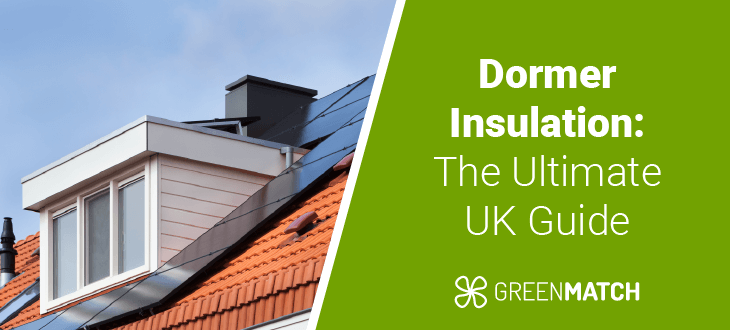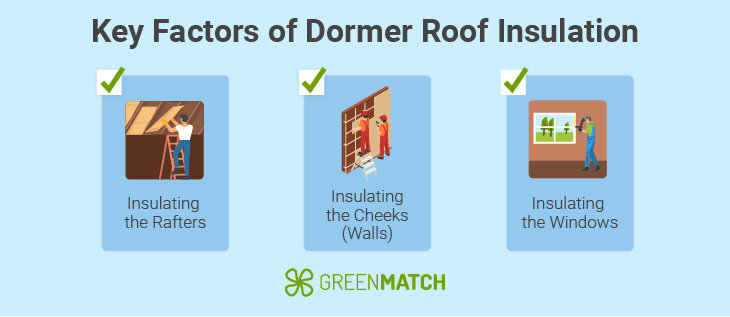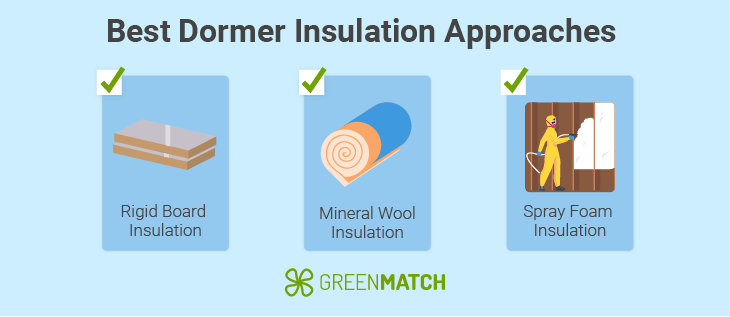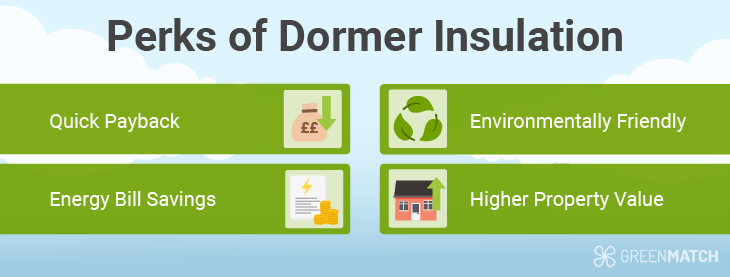Answer these simple questions and we will find you the BEST prices
Which type of solar quotes do you need?
It only takes 30 seconds
100% free with no obligation

Get Free quotes from insulation specialists near you

Save money by comparing quotes and choosing the most competitive offer

The service is 100% free and with no obligation
- GreenMatch
- Insulation
- Roof Insulation
- Dormer Insulation
Dormer Insulation: How to Insulate a Dormer & More


- Dormers can either be insulated from inside the roof by securing insulation to the roof rafters and cheeks (walls) of the dormer, or from outside by adding insulation material to existing roof tiles and covering it with new tiles.
- Dormer insulation is usually incorporated into standard roof or loft insulation, costing about £1,100 in a standard detached UK home.
- Roof, loft and dormer insulation boasts a quick payback period of just 5 years or less, saving a detached home up to £380 on annual energy bills.
Dormer roofs are a tasteful architectural detail commonly found in UK homes. They feature an extractive element to your roof that projects vertically, often complete with windows for a beautiful aesthetic finish. However, dormers are often overlooked when it comes to installing proper home insulation.
This ultimate guide by GreenMatch UK will walk you through everything you need to know about dormer insulation, including the process, regulations, best materials, perks, cons and more.
Ready for a dormer conversion? Look no further than GreenMatch UK for a one-stop solution to all your needs. By spending just 30 seconds filling out our online form, you can receive up to 3 free home-tailored quotes directly from our nationwide network of professionals. No charges or obligations apply. Click below to begin!
- Describe your needs
- Get free quotes
- Choose the best offer
It only takes 30 seconds



How to insulate a dormer

To insulate a dormer, two key parts need to be accounted for. These are the cheeks (walls) and the roof of the dormer space.
Several materials can be used when insulating a dormer depending on your budget, conditions and personal preferences, but the installation process remains relatively the same. Let’s have a look at what to expect:
- Dormer rafter insulation: This process of insulating a dormer roof requires placing insulation material in between and over the rafters above. Rafters can be fitted with mineral wool or rigid insulation boards, leaving at least 50mm of ventilation space to avoid cold bridging. Once the insulation is secured in place, plasterboard can be used to achieve a seamless finish.
- Dormer cheek insulation: Dormer wall insulation can either be applied by directly securing insulation material to the walls and covering them up, or by creating stud walls to store insulation material behind. Insulating dormer cheeks makes sure the protruding shape of the dormer is accounted for.
- Window insulation: To achieve the best efficiency, it’s highly recommended to get double or triple-glazed windows for proper dormer window insulation, as well as draught-proofing of window frames. Insulating dormer windows ensures the best thermal insulation you can get.
It is also possible to insulate a dormer roof from the outside of the house, which requires placing insulation material like rigid boards on top of the existing roof tiles and covering it with a vapour barrier followed by roof tile insulation. This option is however more complex and may require planning permission as it could potentially change the appearance of your home.
Dormer insulation regulations
There are several dormer insulation regulations in place in the UK to ensure that the intended thermal efficiency is provided. These building regs for roof insulation are highlighted in the Part L of the UK Building Regulations document. Let’s have a look at their key expectations:
- Roof span: The existing reach or span of your roof structure cannot be increased or altered without the necessary permissions to do so. Luckily, dormer insulation largely takes place from inside the home and does not require permits to carry out.
- U-value: The expected thermal efficiency for dormer insulation is the same insulation u-value expected for a pitched roof, being 0.16 W/M2 K or less. A key reminder is that the lower the u-value, the more thermally efficient a material is at reducing heat transfer.
- Thermal bridging: Building regulations expect thermal bridging to be limited. This can be achieved by ensuring there is at least 50mm of ventilation space being maintained in the dormer roof rafters. This helps avoid other issues such as moisture ingress, mould, and damaged insulation material.
Professional installers can help navigate these regulations, saving you from strenuous hours of trying to figure out what is expected. However finding the right installer at the right price can often be a difficult task, but that's where GreenMatch UK comes in.
By filling out our simple 30-second online form, we’ll send you up to 3 free home-tailored quotes from our nationwide network of professionals. The best part? It's all free. Click below to begin!
- Describe your needs
- Get free quotes
- Choose the best offer
It only takes 30 seconds



What materials are best for dormer roof insulation?

There is no single best dormer roof insulation material, as your choice will hinge on several factors such as your budget, roof situation, existing insulation and personal preferences. Nevertheless, there are three key ways in which dormers are usually insulated:
- Rigid board insulation: A great balance between thermal efficiency and cost, rigid boards such as PIR or cork have a high thermal capacity and can be cut to fit comfortably within the dormer. An installer will cut 150mm thickness boards into the right sizes, snugly fitting them in between the dormer roof rafters and leaving at least a 50mm ventilation gap to avoid cold bridging. More boards are then secured to the cheeks of the dormer before covering it up with plasterboard for a seamless finish. It’s recommended to work with cork boards over PIR due to their sustainability and recyclability.
- Mineral wool insulation: A more budget-friendly approach is to use rock or glass mineral wool. This process requires the layering of mineral wool sheets of 150mm in the dormer roof rafters and cheeks to a thickness of around 270mm or more to achieve the intended thermal efficiency. These are then secured in place and covered with plasterboard. Mineral wool is also relatively sustainable to work with, comprised mainly of recycled glass or rock.
- Spray foam insulation: Possibly the most thermally efficient but also expensive and unsustainable approach, polyurethane expanding foam allows to achieve high heat retention as well as creating an airtight seal. An installer sprays the foam into the dormer roof rafters, as well as layering it onto the cheeks of the dormer before covering it up with plasterboard for a clean finish. This option is not often recommended due to the risk of harmful chemicals being released, as well as the inherent unsustainability of foam.
Each approach naturally comes with pros and cons worth considering before making a decision. For example, mineral wool may be the most budget-friendly, but it is certainly not the most thermally efficient. Spray foam may be the most efficient, but it is certainly not environmentally friendly. The best approach seems to lie with natural rigid boards such as corkboard, which provide high heat retention, are sustainably produced, and can be endlessly recycled.
Dormer insulation cost in the UK
On average, dormer roof insulation in a standard detached UK home costs around £1,100, including materials and labour. The cost of insulating a dormer is usually wrapped into the general cost of insulating a roof, making it very difficult to predict an accurate sum.
Chances are if you have an uninsulated dormer, you likely also have an uninsulated roof, as roof insulation covers both aspects. Therefore, here is a cost breakdown of what you could expect for standard roof or loft insulation in the UK depending on your home type:
| Home type | Average insulation costs (£) |
|---|---|
| Mid-terrace home | £850 |
| Semi-detached home | £900 |
| Detached home | £1,100 |
| Detached bungalow | £1,200 |
Ultimately, your final investment for dormer insulation will hinge on several factors, some being your budget, existing insulation, outstanding repairs, and even installation complexity. Conducting an assessment with a professional installer can give you a better idea of what you can expect to pay.
Pros and cons of dormer insulation

Dormer insulation is a home upgrade that comes with significant advantages worth considering. These range from your financial security to home comfort, and even environmental considerations. Let’s have a look at some of the main perks of dormer insulation:
- Quick payback: All forms of roof and loft insulation tend to be quite cost-effective and quick in return on investment (ROI). In most cases, roof and loft insulation can pay off the initial investment in just 5 years or less, making it worth every penny.
- Energy bill savings: With proper roof, loft and dormer insulation in place, a standard detached UK home can save up to £380 a year on energy bills. This is due to the increased thermal efficiency, meaning your heating system does not need to work nearly as hard to maintain indoor temperatures.
- Environmentally friendly: In addition to financial savings, proper roof and dormer insulation brings massive cuts to your domestic carbon footprint. With roof insulation alone, you can save up to 1 ton of CO2 every year, benefitting yourself and the planet.
- Higher property value: Homes with adequate insulation in place are generally valued higher in the housing market. This is because prospective customers know they are comfortable to live in, will have lower energy bills, and likely won't suffer from dampness and mould. Insulating your dormer can help you earn more through rent and selling.
Since dormer insulation is a smaller detail in home insulation, it does not come with any significant costs that outweigh its benefits. Perhaps the only key con worth considering is that choosing to insulate your dormer from the outside of your home will be more costly, labour-intensive and messy than insulating from the inside.
Is dormer insulation a good solution for your loft?
All in all, dormer insulation is a wonderful step to take in ensuring your home is properly insulated, providing that extra step in ensuring an effective thermal envelope. Any roof or loft insulation should also account for the dormer space to make sure all avenues are accounted for.
Deciding to insulate your dormer is easy, but finding a professional installer at the right bargain can sometimes feel like looking for a needle in a haystack. With the endless options for professionals on the market, prospective customers find themselves stuck in an endless cycle of researching and vetting. Luckily, GreenMatch UK can free you of this burden.
By spending just 30 seconds filling out our simple online form, you can receive up to 3 free home-tailored quotes directly from our nationwide network of pre-vetted professionals. The best part? Our services are completely free of charges and obligations. Click the button below to begin and land yourself the best value on dormer insulation!
- Describe your needs
- Get free quotes
- Choose the best offer
It only takes 30 seconds



FAQ
Dormers can be insulated by placing insulation material in the dormer roof rafters and cheeks (walls) from the inside. Alternatively, insulation material can be placed from outside of the dormer and covered with new roofing tiles, but this process is more costly and labour-intensive.
An existing dormer can be insulated by placing insulation material in the roof rafters of the dormer, as well as by securing insulation to the inner walls (cheeks) of the dormer from the inside of the roof. It’s also possible to secure insulation material to the outside roof of the dormer and cover it with new roof tiles.
The best insulation for dormers depends on your budget and preferences. Overall, corkboard insulation and other rigid insulation boards emerge as the best cost-to-performance ratio as they exhibit high thermal retention at a better cost margin than spray foam.
The amount of insulation you need in a dormer depends on your chosen insulation material. For example, rigid boards would require at least 150mm of thickness, whereas mineral wool would require 270mm or more of insulation thickness.
It’s difficult to predict the cost of dormer insulation alone, as this cost is often wrapped up with the overall investment needed for roof or loft insulation. Nevertheless, the cost of insulating a roof or loft in a standard detached UK home is around £1,100 for a full job.

Akif is a copywriter at GreenMatch since 2023. With a keen interest in community sustainability, green solutions and the role of digital media in identifying climate trends, he aims to hone in on his background in International Studies and Digital Media to provide a multidisciplinary approach to written content rooted in credible research and accuracy.
We strive to connect our customers with the right product and supplier. Would you like to be part of GreenMatch?

